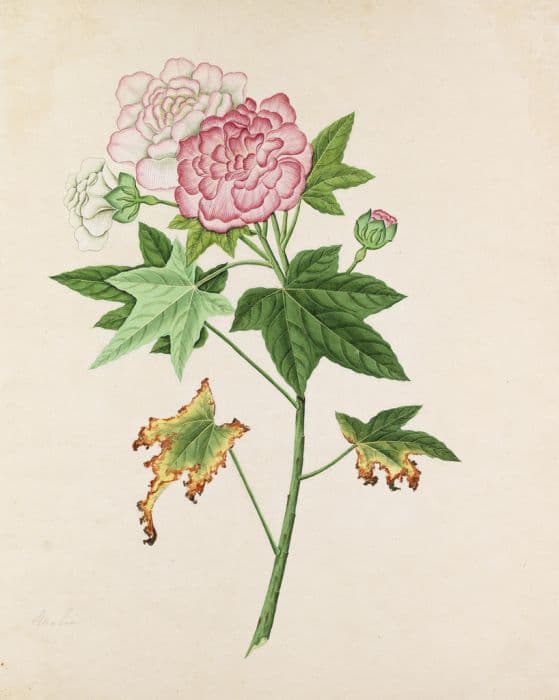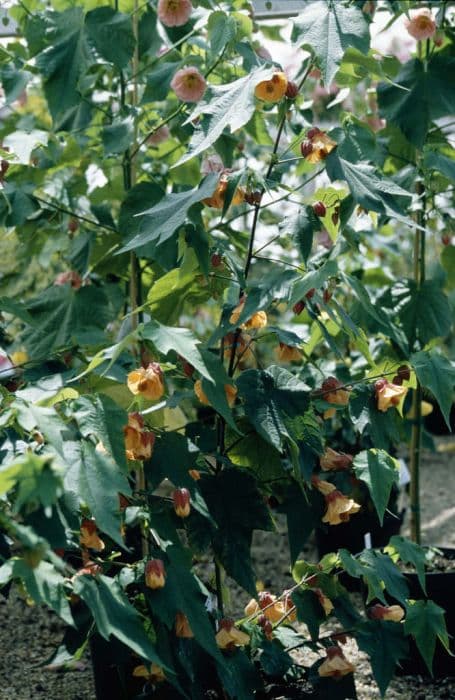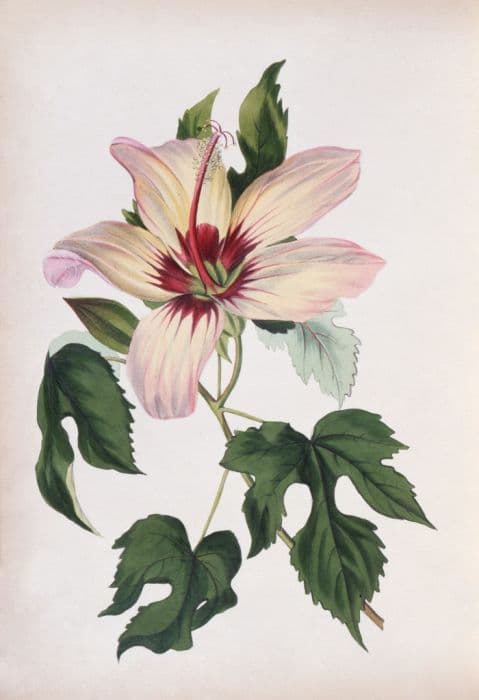Confederate Rose Hibiscus mutabilis

ABOUT
Hibiscus mutabilis, commonly known as the Confederate rose, is a showy plant known for its large, attractive flowers. The Confederate rose is not a true rose, but its flowers can resemble those of a rose in shape and size. The flowers are typically known for their color-changing ability, starting out pure white in the morning and gradually transitioning to pink and then to a deep red by evening. Each flower boasts multiple layers of overlappping petals that create a full, rounded appearance, giving it a lush, voluminous look. The leaves of the Confederate rose are heart-shaped with a fine, toothed margin, providing a textured and appealing background to the dramatic blooms. The foliage is deep green, with a slightly glossy surface that catches the light. The leaves can be quite large, contributing to the plant's overall bushy, dense silhouette. Throughout different stages in its bloom cycle, the Confederate rose can be a delightful visual spectacle. It's known to flower late in the summer and into the fall, providing a splash of color when many other plants begin to wind down. This distinctive color-changing trait, combined with the plant's vibrant green foliage, makes the Confederate rose a favorite among gardeners looking to add a dynamic and dramatic element to their landscapes.
About this plant
 Names
NamesFamily
Malvaceae.
Synonyms
Confederate Rose, Cotton Rose, Dixie Rose Mallow, Changeable Rose, Confederate Rose Mallow.
Common names
Hibiscus sinensis var. mutabilis, Hibiscus cucurbita, Hibiscus gloriosus, Hibiscus laevis, Ketmia mutabilis.
 Toxicity
ToxicityTo humans
The common name for Hibiscus mutabilis is Confederate Rose. Generally, this plant is not considered toxic to humans. However, like with any plant material, some individuals may have allergic reactions or sensitivity. Ingestion of any part of the non-toxic plant typically does not result in serious poisoning. But it is always prudent to exercise caution and avoid eating parts of ornamental plants without verifying their edibility.
To pets
The Confederate Rose, known scientifically as Hibiscus mutabilis, is not considered toxic to pets. This includes both dogs and cats. There are no significant symptoms of poisoning associated with this plant, and it is not known to cause severe health issues if ingested by pets. However, individual animals might have sensitivity or allergic reactions, and it's always a good idea to discourage pets from chewing on ornamental plants as a precaution.
 Characteristics
CharacteristicsLife cycle
Perennials
Foliage type
Deciduous
Color of leaves
Green
Flower color
Mixed
Height
6-15 feet (1.8-4.6 meters)
Spread
6-10 feet (1.8-3 meters)
Plant type
Shrub
Hardiness zones
7
Native area
China
Benefits
 General Benefits
General Benefits- Ornamental Beauty: Hibiscus mutabilis, commonly known as the Confederate Rose, is highly valued for its large, showy flowers that can add aesthetic appeal to gardens and landscapes.
- Seasonal Interest: The flowers of the Confederate Rose undergo a color change throughout the day and with age, often transitioning from white to pink to red, providing a unique and dynamic display.
- Habitat for Wildlife: The plant serves as a habitat and source of nectar for pollinators such as bees, butterflies, and hummingbirds, thus supporting local ecosystems.
- Shade Provider: With its sizeable bushy growth, Confederate Rose can be utilized to provide shade in gardens and outdoor spaces on sunny days.
- Privacy Screen: Due to its dense foliage and height, it can be planted as a living privacy screen or hedge to delineate boundaries and reduce noise.
- Erosion Control: The Confederate Rose can help stabilize the soil with its root system and is useful in preventing soil erosion in certain landscapes.
- Cultural Significance: The plant has cultural importance in certain regions and is often associated with historical gardens, providing a sense of heritage and continuity.
 Medical Properties
Medical Properties- Anti-inflammatory: Hibiscus mutabilis has been used traditionally to reduce inflammation.
- Wound healing: The plant is believed to promote the healing of cuts and bruises.
- Antipyretic: Its cooling properties have been used to reduce fevers.
- Menstrual pain relief: Some practices include the use of this plant to alleviate menstrual discomfort.
- Diuretic effects: Hibiscus mutabilis may be utilized to increase urine production, possibly aiding in reducing fluid retention.
- Skincare: Extracts from the plant are sometimes used in skin care products to improve skin health and treat certain skin conditions due to its antioxidant properties.
 Air-purifying Qualities
Air-purifying QualitiesThis plant is not specifically known for air purifying qualities.
 Other Uses
Other Uses- Hibiscus mutabilis, commonly known as Confederate rose, can be used as a natural dye for fabrics, yielding a light green or yellowish color depending on the mordant used.
- The large, showy flowers of Confederate rose are suitable for use in floral arrangements, particularly in the Southern United States where they can add a touch of charm to traditional decor.
- The Confederate rose can be planted as a living fence or privacy hedge due to its dense foliage and rapid growth in warm climates.
- The wood of the Hibiscus mutabilis is light and can be used for making small handcrafts and ornamental objects.
- In cooler regions, this plant can be grown as an annual, maintaining its ornamental value in temperate gardens where it won't survive the winter.
- The Confederate rose can be used in educational botanical gardens to demonstrate the phenomenon of flowers changing color throughout the day.
- The plant's large leaves can be used for creating shade in garden sitting areas, providing relief from summer heat.
- The broad leaves of the Confederate rose could be creatively used in art for leaf-painting activities, especially with children.
- The robust nature of the Confederate rose makes it an excellent plant for erosion control on slopes or areas prone to soil degradation.
- Due to its rapid and robust growth, the Confederate rose can be used in reclamation projects to help stabilize soil and support biodiversity in degraded landscapes.
Interesting Facts
 Feng Shui
Feng ShuiThe Confederate Rose is not used in Feng Shui practice.
 Zodiac Sign Compitability
Zodiac Sign CompitabilityThe Confederate Rose is not used in astrology practice.
 Plant Symbolism
Plant Symbolism- Delicate Beauty: Hibiscus mutabilis, also known as Confederate Rose, often symbolizes delicate beauty due to its large, showy blooms and soft, changing colors.
- Femininity: With its association with beauty and its soft, layered petals, the Confederate Rose is frequently seen as a representation of femininity.
- Mutability: The flower's ability to change colors—from white to pink to red—throughout the day symbolizes changeability and adaptability.
- Transient Nature: The Confederate Rose's blooms are known for their short-lived beauty, symbolizing the transient nature of life and reminding us to appreciate the present moment.
 Water
WaterThe Confederate Rose, commonly known as Hibiscus mutabilis, should be watered deeply, allowing the water to reach the roots, usually about once a week. During the growing season in spring and summer, it may require more frequent watering, especially if the weather is particularly hot or dry, potentially increasing to twice a week. Each watering should be enough to moisten the soil to a depth of at least 8 inches, which typically means using around 1 to 2 gallons of water per plant, depending on soil type and temperature. In the winter, watering should be reduced as the plant enters a dormant period. Always check the soil moisture before watering; if the soil is still moist from the previous watering, wait until it has dried out to a depth of about 2 inches.
 Light
LightThe Confederate Rose thrives best in full sun to partial shade. It should be placed in a location where it receives at least six to eight hours of direct sunlight each day for optimal flowering. However, in extremely hot climates, some afternoon shade can be beneficial to prevent stress on the plant.
 Temperature
TemperatureThe Confederate Rose prefers warm conditions and can typically handle temperatures ranging from 60 to 90 degrees Fahrenheit. It can tolerate minimum temperatures down to around 40 degrees Fahrenheit, but below this point, the plant may suffer cold damage. The ideal temperature for this plant is a comfortable room temperature, between 60 and 80 degrees Fahrenheit.
 Pruning
PruningPruning the Confederate Rose is essential for shaping the plant, encouraging bushier growth, and removing any dead or diseased wood. The best time for pruning is in late winter or early spring before the new growth begins. Pruning can be done annually, cutting back about one-third of the older branches to stimulate new growth and flower production.
 Cleaning
CleaningAs needed
 Soil
SoilConfederate Rose, commonly known as Hibiscus mutabilis, thrives in a well-draining soil mix that consists of equal parts loam, peat, and sharp sand or perlite. Aim for a soil pH between 6.0 and 7.0, which is slightly acidic to neutral. This provides a healthy environment for root growth and nutrient uptake.
 Repotting
RepottingConfederate Rose (Hibiscus mutabilis) should be repotted every 2 to 3 years to ensure it has enough space for root growth and access to fresh nutrients in the new soil. When repotting, gently prune the roots if they are excessively crowded.
 Humidity & Misting
Humidity & MistingConfederate Rose (Hibiscus mutabilis) prefers high humidity levels, ideally between 50% to 70%. It thrives in environments that mimic its native subtropical habitat which can be maintained through regular misting or using a humidifier.
 Suitable locations
Suitable locationsIndoor
For Confederate Rose, ensure bright indirect light, warm temps, and high humidity.
Outdoor
Place Confederate Rose in partial sun, protect from cold, and water regularly.
Hardiness zone
7-11 USDA
 Life cycle
Life cycleThe Confederate rose (Hibiscus mutabilis) begins its life cycle as a seed, which, when planted in well-draining soil and with adequate warmth and moisture, will germinate and sprout. The emerging seedling will develop into a young plant with characteristic heart-shaped leaves. As the plant matures, it grows into a large shrub that may reach several meters in height and blooms yearly, typically from late summer to fall, showcasing large, showy flowers that change color throughout the day from white to pink and then to red. After pollination, typically by insects attracted to its color and nectar, the flowers will produce dry, five-lobed seed capsules, containing numerous seeds that are dispersed by wind, water, or animals. The plant will then enter a dormant period during colder months if exposed to a temperate climate, losing leaves and halting growth. With the return of suitable growing conditions, the Confederate rose resumes growth, setting the stage for the cycle to repeat.
 Propogation
PropogationPropogation time
Spring to summer
The Confederate rose, commonly known as Hibiscus mutabilis, is often propagated by cuttings, which is the most popular method for this plant. The optimal time for taking cuttings is in late spring to early summer when the plant is actively growing. Cuttings should be about 6 to 8 inches long and contain several sets of leaves. The lower leaves are removed and the cut end is dipped in rooting hormone to encourage root growth. The prepared cuttings are then inserted into a well-draining soil mix, and the environment is kept humid by covering the cuttings with a plastic bag or placing them in a propagator. It is essential to keep the soil moist but not waterlogged, and place the cuttings in a warm location with indirect light. Rooting typically occurs within a few weeks, after which the new plants can be gradually acclimatized to less humid conditions before transplanting.









